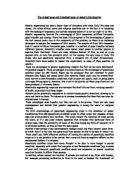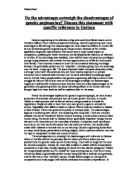There are advantages to genetic engineering; despite the fact we are more informed of its possible dangers. These advantages are mainly known in the advantages of genetically modified crops (or GM foods). Plants can be produced that are resistant to plant diseases (like fungi) and animal pests (like insects). Plants could also be created that could survive in less favourable conditions, such as poor soil quality, such as giving plants a nitrogen fixing capacity. However, this is yet to be proved, as these crops have not yet been produced, it is merely theory.
Genetically engineering crops can also increase the shelf life our food, reducing amounts of waste, as products will keep longer.
Animals can be genetically engineered to contain human genetic disorders, allowing us to carry out tests on them. This allows us to develop treatments for them that can later be administered to humans.
These advantages seem hopeful, but they are yet to be proven. There are also many consequences and beliefs that genetic engineering is wrong for moral or religious reasons.
The first disadvantage of genetically engineering crops is the likelihood of genes transferring from GM (genetically modified) crops to other crops. For example, oilseed rape can cross-pollinate wild relatives. This would reduce the variation of crops across the world, so if a new plant disease appeared that attacked that particular form of oilseed rape, then the possibility of some of the crop having any form of immunity to it is extremely unlikely, as they all have the same genes.
Another disadvantage is any environmental damage would only show several years later, by which time it is too late. Any gene would have spread too far to be able to trace it all. There aren’t any 100% effective methods of testing the safety of genetically modified crops so it is not possible to be certain that a crop will have no negative effects on the environment before it is released.
Genetically modified crops have been thought to be able to solve hunger in poorer countries, especially with crops that can grow in less favourable conditions (e.g. in areas of poor soil). However, genetically modified seeds are expensive, so poorer countries would not be able to afford them anyway.
In addition, where animals are involved, if animals are involved in any form with humans, for example, producing antibiotics in them to be used in humans for treatment of disease, then we are instantly exposing ourselves to any disease that animal could contract. This should not be a risk we are willing to take.
Another argument is that the manipulation of plant and animal DNA could be leading to the genetic manipulation of humans, which would cause a public outcry.
Should we be allowed to tamper with genetic make-up when it has progressed without interruption from humans for billions of years? Religious people believe we should not tamper with what god created. Should we be carrying out research into an area many people feel strongly against? These are the kinds of moral questions we should consider before we take this any further, although scientists are proceeding with research without fully considering the beliefs of other people, believing they are doing is right. Surely we should be seriously considering the implications of our actions involving genetic engineering, as the next breakthrough could be tomorrow.






